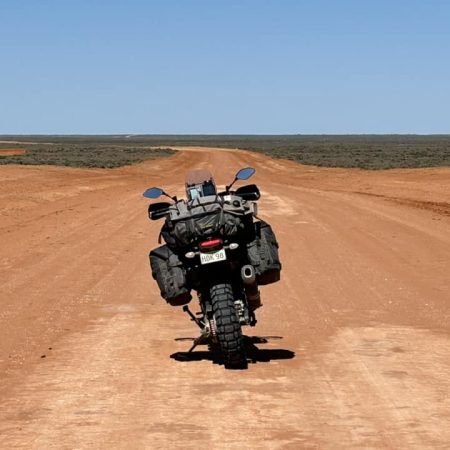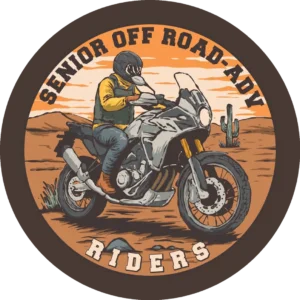Transitioning From Asphalt to Adventure
Where Experience Meets Exploration

Many riders who have spent decades on road bikes eventually begin to look for something different. After years of familiar highways, predictable day trips, and the same destinations, it is common to feel the urge to explore beyond the limits of paved roads. This shift often happens later in life, when the desire for new experiences becomes more important than staying within a well-worn routine.
Adventure motorcycles offer a way to rediscover riding without leaving behind the skills and instincts developed over thousands of miles on the road. They present an opportunity to travel with more freedom, to avoid crowded highways, and to experience a sense of self-reliance that is difficult to find in any other form of riding.
One of the most significant changes that draws experienced riders toward adventure bikes is the reduction of time spent in dense traffic. While any motorcycle requires vigilance around other vehicles, adventure riding tends to favor quieter backroads, forest service routes, and remote byways where there is less competition for space and fewer distracted drivers. For many, this shift alone feels like a relief. The inherent risk of sharing multilane highways with inattentive drivers is one of the most pressing safety concerns for road riders. Traveling routes with less congestion not only lowers the likelihood of an accident but also allows for a more relaxed state of mind.
The machines themselves are designed to serve a different purpose. An adventure bike is built to handle a mix of pavement, gravel, and dirt. It has longer suspension travel, a more upright seating position, and ground clearance to manage obstacles that would be impossible on most street-oriented motorcycles. Examples like the BMW R 1250 GS, Honda Africa Twin, and Suzuki V-Strom are equipped with features that make them capable on highways but ready for conditions where traction and terrain constantly change.
For riders accustomed to low-slung cruisers or touring bikes with plush seats and floorboards, the first impression of an adventure motorcycle can be striking. The seat height is often taller, the stance more aggressive, and the weight balanced differently. Learning to maneuver these machines off-pavement takes practice. Standing on the pegs to maintain stability over rough ground becomes standard. Throttle and brake inputs need to be more measured, especially when traction is inconsistent. These differences create a learning curve, but many riders find the process rewarding because it reinvigorates their interest in riding.
The appeal of adventure riding goes beyond the technical aspects. It is also about the possibilities that come with a machine built to go almost anywhere. Riders who have spent years limited to established routes discover they can reach places that are inaccessible by car or road bike. Remote campsites, scenic overlooks, and backcountry tracks become part of everyday planning rather than occasional exceptions. This freedom to travel without concern for whether the pavement ends is a central reason so many riders choose to make the switch.
Adventure riding often emphasizes preparation and self-reliance. Unlike strictly paved touring, where fuel stops and lodging are predictable, backcountry travel requires more careful logistics. Riders must plan fuel range, carry tools for minor repairs, and pack clothing suitable for sudden weather changes. This sense of responsibility can feel refreshing for riders who want more engagement in their travels. For many, it is precisely this element that makes adventure riding feel like an authentic pursuit rather than simply another way to pass time.
Another factor that attracts experienced riders is the culture surrounding adventure bikes. The community tends to value practical knowledge over appearance. There is less focus on style and more on sharing information about routes, gear, and technique. Riders often compare notes on navigation equipment, luggage systems, and mechanical solutions rather than chrome accessories or paint. This approach appeals to individuals who appreciate substance and the satisfaction of being prepared.
Physical engagement also becomes part of the attraction. Riding an adventure bike on varied terrain demands balance, core strength, and endurance. For older riders, this activity can help maintain mobility and fitness in a way that feels purposeful. It is not simply exercise for its own sake but a means of supporting the ability to explore. Many discover that they feel stronger and more focused after a season of riding that includes time spent off-pavement.
While the transition to adventure motorcycling brings clear benefits, it also requires an adjustment in mindset. Even experienced riders need time to develop the confidence to handle unpredictable surfaces. Sand, mud, loose gravel, and rocky paths each introduce challenges that do not exist on asphalt. Respect for these conditions is essential. Many riders choose to invest in professional training to build foundational skills and avoid frustration early on. A training course can speed up the learning process and reduce the likelihood of injuries or unnecessary damage to equipment.
Packing also changes in ways that surprise many riders. Adventure bikes are designed to carry more weight over longer distances, but that weight must be balanced carefully to avoid affecting handling. Luggage is often secured higher than on street bikes, which can take time to get used to when cornering or maneuvering at slow speeds. Selecting gear that is weather-resistant, lightweight, and modular becomes a priority, especially for multi-day trips.
The riding experience itself tends to feel more varied and less predictable. A day’s plan may include stretches of highway, gravel roads, and remote tracks that require constant adjustments in speed and technique. For riders who have spent years covering familiar routes, this variety creates a sense of exploration and progress. Each ride becomes an opportunity to learn something new, whether it is about the landscape, the machine, or personal limits.
Riders who choose to step away from strictly pavement-focused travel often describe the change as revitalizing. The combination of reduced exposure to traffic hazards, access to more diverse destinations, and the mental engagement of planning and preparation make adventure riding feel like a meaningful evolution rather than a compromise.
Switching to an adventure bike is not simply about changing motorcycles. It is about rethinking what riding can be. For those willing to adapt, the experience opens up possibilities that extend far beyond any single road or destination. The sense of freedom, self-sufficiency, and discovery can make this transition one of the most satisfying chapters in a lifetime of motorcycle riding.
-Kevin Cave

